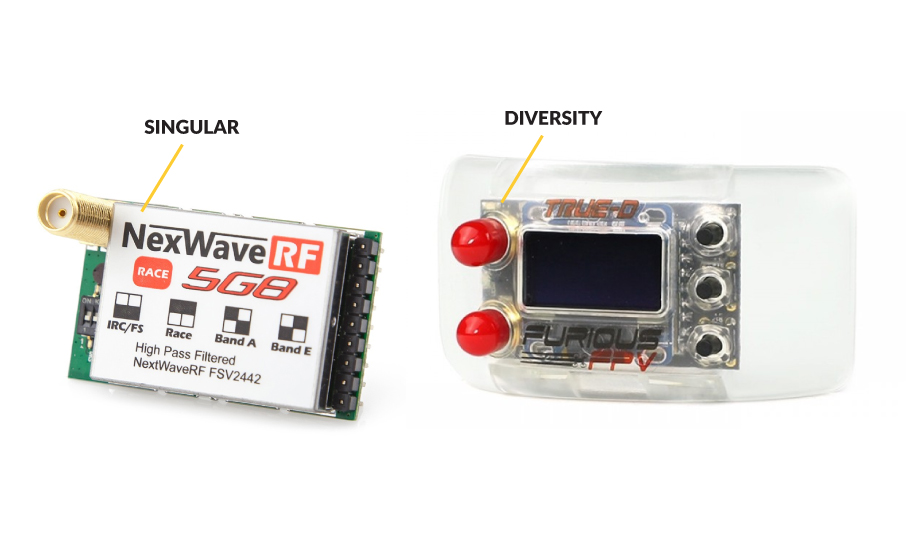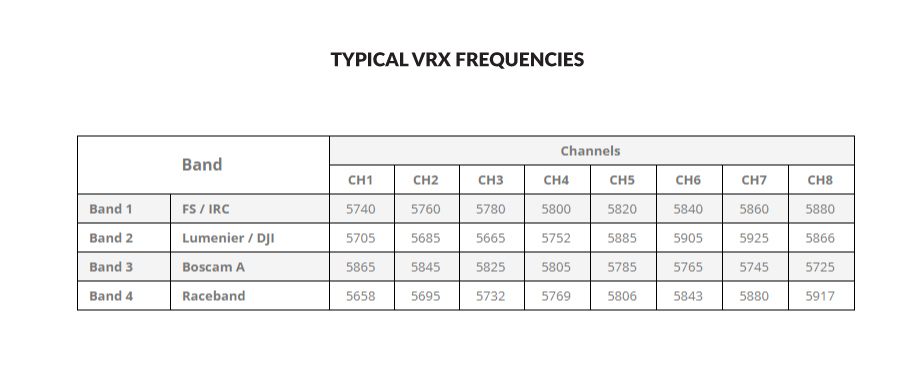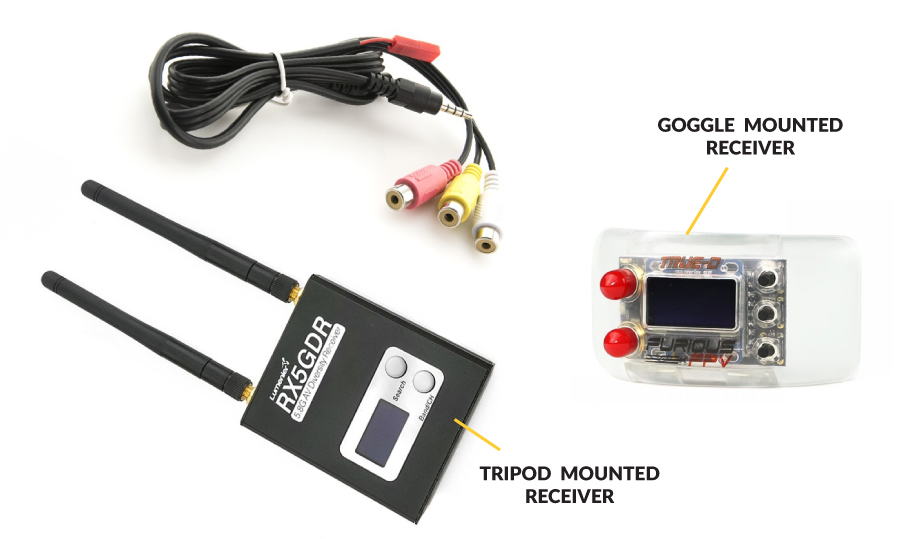* All About Multirotor Drone FPV Video Receivers
All About Multirotor Drone FPV Video Receivers
A Drone FPV Video Receiver (VRx) is a crucial part of the FPV system!
Drones equipped with first person view (FPV) systems will typically have a small,
simple camera mounted on the front. The video signal from the camera is sent to the
video transmitter where it is formatted, amplified and broadcasted.
This video information from the drone would be of little use if not for the video receiver
on the ground. As the name implies, video receivers act to receive the radio frequency (RF)
waves carrying the video/audio information from the drone and convert this into a usable
video signal to be displayed in your goggles. At a basic level, the video receivers work very
much like the video transmitters, but in reverse.
The RF video signal from the drone is picked up by the receiver antenna.
It is amplified and formatted by the receiver and sent to the goggles, all with incredible speed!
Although there are both digital and analog FPV systems available, for this article we will
focus on analog systems, although digital systems have come down in price,
and their performance continues to improve, analog systems are still the most widely used.
Singular and Diversity Modules
The simplest Drone FPV Video Receiver have one receiver module, requiring a single
antenna. However, for optimal RF video reception, it has been found that using 2 separate
receiving modules working together, called diversity, performs the best. In these receivers
there are actually 2 receiver modules, each with their own antenna.
A logic board will select the best video signal from the two modules based on the
signal strength and send that signal off to the goggles. The switch between receiver modules
happens rapidly and without a glitch, so the video receiver is always providing the pilot with
the best video signal. Generally, diversity systems will have a single omnidirectional
antenna and another antenna which is usually a directional antenna.

Drone FPV Video Receiver Frequencies
For racing and freestyle drones, the optimal frequency for video transmission is the
5.8 GHz band. In the United States this is one of the RF bands which falls under the ISM
(industrial, scientific, medical) classification from the federal communications commission (FCC).
These frequencies are available to users license-free in the power levels which drones generally
operate. The 5.8 GHz frequency allows for the use of smaller antennas, has good range and
can carry a relatively high resolution video signal. There are other frequencies available
for video transmission, such as 2.4 GHz, 1.3 GHz, and 900 MHz, however, based on the size
of racing and freestyle drones the 5.8 GHz band has been proven to be the best fit.
Therefore, when building or buying your drone, be sure to match the frequency
of your video transmitter to your video receiver.
Within the 5.8 GHz frequency, we actually use a range of frequencies, from 5.3 GHz to 5.9 GHz.
The 5.8 band has been divided up into “channels.” For example, the “race band” has 8 channels,
separated by 37mhz, with the lowest channel being 5658 MHz and the highest channel
being 5917 MHz. This has been optimized to allow up to 8 pilots to fly simultaneously under
ideal conditions. At a race or when flying with friends it is best to pick channels that are
as far away from each other as possible, so that video interference between the drones is minimized.
Current video transmitters and video receivers generally have a minimum of 40
total channels, with 5 bands, such as the Race Band, each containing 8 channels.

Types of Drone FPV Video Receiver
Video receivers may be mounted on tripods, with the goggles plugged in to the receiver
with an A/V cable. Conversely, video receivers have been shrinking in recent years,
allowing for the integration of diversity systems into modules that can fit in goggles.
For long range FPV it is generally better to have the video receiver mounted on a tripod so
that the longer range directional antenna can be pointed towards the craft. For racing and
freestyle however, pilots have had great success with the goggle-based modules.
Some video receivers also have extras, like an auto-scan to see the RF noise floor or
what channels are already in use around you. They may also have channel memory,
to quickly switch between two or more favorite channels. While these options are convenient,
they are not necessary when first starting, and these units often have the same
sensitivity and clarity of video as more simple and inexpensive units.
Conclusion
FPV video receivers are a critical part of the FPV system. Video receivers work to turn the
RF signal from your drone into clear video for your goggles. Your choice of video receiver
depends on your video transmitter frequency, which for racing and freestyle is likely to
be the 5.8 GHz band. The other option for receivers is whether you want a goggle or
tripod-mounted setup, although most pilots now run the goggle-mounted diversity systems
for convenience and performance. Video receivers are relatively simple to use,
and can have as many or as few features as you would like.
